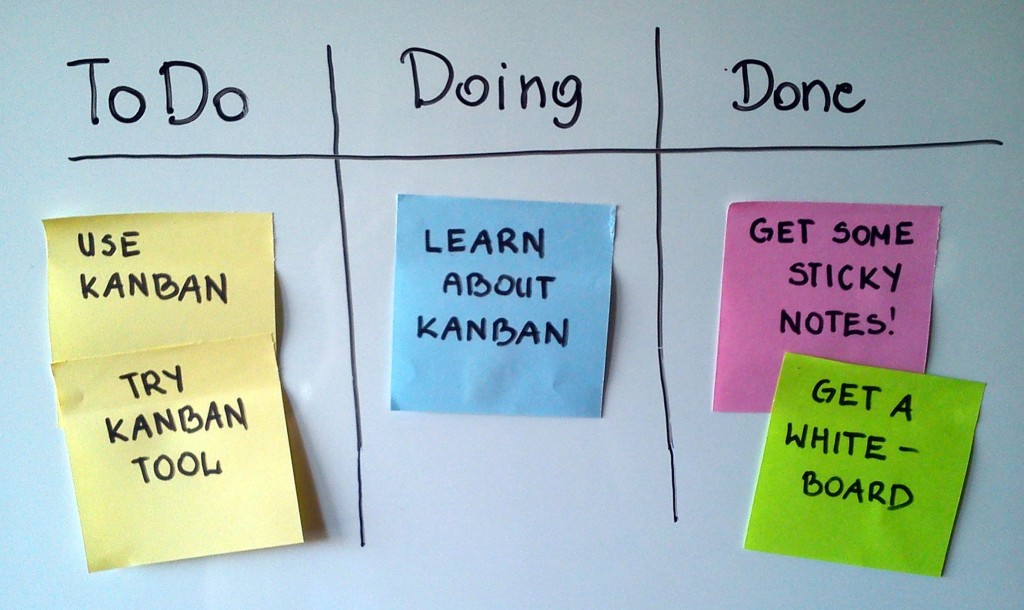
In my last post, I discussed effort estimation and scheduling, which leads into the beginning of actual development. But first, you need to decide how you’re going to track progress. Here are some commonly used methods:
The Big Board
In keeping with Agile philosophy, you should choose the simplest tool that gives you the functionality you need. If your team does all of its development work in the same physical space, you could get by with post-it notes on a big white board. There’s a lot to be said for a tangible object: it communicates the independent nature of each task or story in a way that software may not. It provides the team with a ready-made meeting point: if you want to see how the project is going, you have to go stand in front of the big board. A board can also help to keep projects lean and simple, because there’s only so much available space on it. There are no multiple screens or pages to hide complexity.
Sticky notes, however, are ephemeral in nature. You can lose your entire project plan to an overzealous janitor; more importantly, unless you periodically take pictures of your board, there’s no way to trace user story evolution. Personally, I like to use this method in the initial stages of planning; the board is a very useful anchor for user story definition and prioritization. Once we move into the development process, I find that moving into the virtual realm adds crucial flexibility and tracking functionality.
Spreadsheets
If the scope of the project is limited, it may be possible to track it using a basic office productivity suite like MS Office. MS Excel and similar spreadsheet tools are fairly easy to use, and they’re ubiquitous, which means your team will likely face a lower learning curve. Remember that in Agile the business side of the organization is an integral part of the development effort, and it may not make sense to spend time and effort to train sales and management staff on a complex tracking tool.
If you choose to go the spreadsheet route, however, you are giving up some functionality: it’s easy enough to create and maintain spreadsheets that give you project snapshots and track current progress, but this type of software is not designed to accurately measure long term progress and productivity, which helps you upgrade your processes and increase your team’s efficiency. There are ways to track Agile metrics using Excel, but if you find that you need to do that you may just want to switch to dedicated software anyway.
Tracking Software
There are several tracking tools out there that can help manage Agile projects, although my personal experience so far has been limited to to JIRA and its companion GreenHopper. JIRA is a fairly simple issue-tracking tool: you can create issues (manually or directly from a reporting form), add a description, estimate effort, prioritize, and assign to a team member for completion. You can also track it through the various stages of development, adding comments at each step of the way and preserving meaningful conversations about its progress and evolution. As you can see in this article comparing similar tools, JIRA’s main advantage is the lack of unnecessary UI complexity, which makes it easier to master. Its main shortcoming is the lack of sprint management functionality, which is what GreenHopper provides. With the add-on, users can create sprints, assign tickets to them, and track sprint progress.
Can all of this functionality be replicated using spreadsheets? Yes, although maintenance and authentication can becomes problematic as the complexity of the project increases. At some point a tool like JIRA starts to pay for itself in terms of increased efficiency, and most if not all of these products are web-based and offer some sort of free trial or small enterprise pricing. My advice is to do analyze your operations to determine if you need to go the tracking tool route, and then some basic research to identify popular options and their pros and cons. Once you’ve identified one or two options that seem to fit your needs, give then a try to see if they’re what you’re looking for.
Again, which method you go with will depend on how much effort you will need to spend up front (in training and adapting new software) versus later on (added maintenance and decreased efficiency).
How do you track user story progress? What are the big advantages/disadvantages of your chosen method? JIRA in particular seems to elicit strong feelings in users, positive or negative; what are your thoughts on it?
Pingback: Teamwork and Jazz | LITA Blog